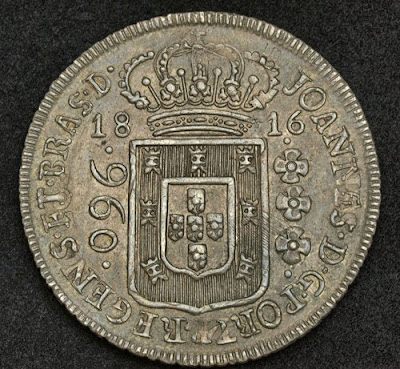 |
| Brazilian Coin |
 |
| Brazilian 960 Reis silver Coin |
Obverse: Crowned shield of the United Kingdom of Portugal, Brazil and the Algarves, splitting date (1816).
Legend: JOANNES . D.G . PORT . REGENS . ET . BRAS . D . / . 960 . / . *** .
Reverse: Round globe over cross of Jerusalem (cross of the Order of Christ). Boldly struck mint initial (B) on diagonal band of globe.
Legend (motto): . SIGN . NATA STAB . SUBQ .
Expanded: SUBQUO SIGNO NATA STABIT
Tranlsated: "For this sign you shall stand"
Reference: KM-307.1.
Mint Mark: "B" (for Bahia )
Denomination: 960 Reis
Weight: 26.78 gram of Silver
Diameter: 41 mm
John VI of Portugal
John VI (Portuguese: Dom João VI; 13 May 1767 – 10 March 1826) was King of the United Kingdom of Portugal, Brazil and the Algarves from 1816 to 1822, and, although de facto the United Kingdom over which he ruled ceased to exist, he remained so de jure from 1822 to 1825; after the recognition of Brazilian independence under the 1825 Treaty of Rio de Janeiro, he continued as King of Portugal and the Algarves until his death in 1826. Under the said Treaty he also became Titular Emperor of Brazil for life, while his son, Emperor Pedro I, was both de facto and de jure the monarch of the newly independent country.
Born in Lisbon in 1767, the son of Peter III of Portugal, and Queen Maria I, he was originally an infante (prince not heir to the throne) of Portugal, and only became heir to the throne when his older brother, José, Prince of Brazil, died in 1788, of smallpox, at the age of 27.
Before his accession to the Portuguese throne, John VI bore the titles of Duke of Braganza and Duke of Beja, as well as the title of Prince of Brazil. He served, from 1799, as Prince Regent of Portugal (and later, from 1815, as Prince Regent of the United Kingdom of Portugal, Brazil and the Algarves), due to the mental illness of his mother, the Queen. Eventually, he succeeded his mother as monarch of the Portuguese Empire, with no real change in his authority, since, as Regent, he already possessed absolute powers.
One of the last representatives of absolutism, he lived during a turbulent period; his reign never saw a lasting peace. Throughout his period as Regent and later King, such major powers as Kingdom of Spain, Kingdom of France and its later successor the First French Empire and Great Britain (from 1801, the United Kingdom of Great Britain and Ireland) continually intervened in Portuguese affairs. Forced to flee to South America across the Atlantic Ocean into Brazil when troops of the Emperor Napoleon I invaded Portugal, he found himself faced there with Liberal revolts that reflected similar events in the metropolis; he was compelled to return to Europe amid new conflicts. His marriage was no less conflictual, as his wife, Carlota Joaquina of Spain, repeatedly conspired against her husband in favor of personal interests or those of her native Spain. He lost Brazil when his son Pedro declared independence, and his other son Miguel (later Miguel I of Portugal) led a rebellion that sought to depose him. According to recent scholarly research, his death may well have been caused by arsenic poisoning.
Notwithstanding these tribulations he left a lasting mark, especially in Brazil, creating numerous institutions and services that laid a foundation for national autonomy, and is considered by many researchers the true mastermind of the modern Brazilian state. Still, he has been widely (if unjustly) viewed as a cartoonish figure in Luso-Brazilian history, being accused of laziness, lack of political acumen and constant indecision, and often portrayed as physically grotesque.